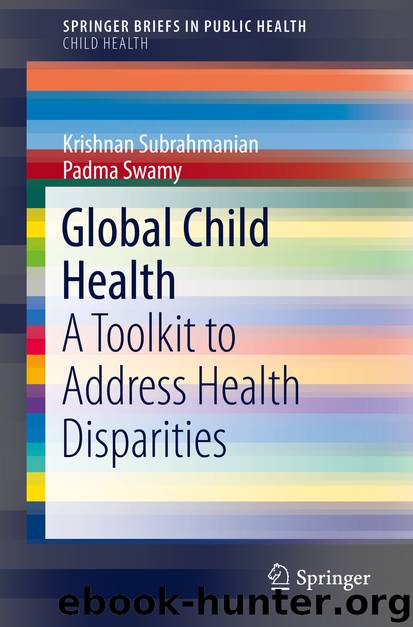Global Child Health by Krishnan Subrahmanian & Padma Swamy

Author:Krishnan Subrahmanian & Padma Swamy
Language: eng
Format: epub
Publisher: Springer International Publishing, Cham
Malnutrition
Malnutrition is defined by the WHO defines as “deficiencies, excesses, or imbalances” in a person’s diet (World Health Organization 2016). There can be under-nutrition which includes stunting, wasting, and micronutrient deficiency . There is also over-nutrition which is obesity and overweight. The obesity and overweight conditions will be discussed in more detail in the Non-communicable disease part of this section.
Health Impacts of Undernutrition
Forty-five percent of all childhood deaths in 2011 was attributable to undernutrition (Black et al. 2013).This is a public health issue with children dying from severe acute malnutrition or not reaching their full developmental potential due to undernutrition. Another significant issue related to undernutrition, is the risk that it places for children for developing pneumonia and diarrheal disease . While a causal pathway has not been surmised for malnutrition and immunity , there has been an association (Black et al. 2013). There have been several studies that have looked at the impact of malnutrition on the lymphatic and hematopoietic system , also studies have shown that there are malnutrition associated changes to the intestinal flora causing for inflammation and immune dysregulation (Black et al. 2013).
The presentation of a child with severe acute malnutrition can vary. According the WHO, severe acute malnutrition (SAM ) is defined as weight less than the 3 standard deviations below the mean (−3z score), or less than 70% of ideal body weight based on WHO/National Health Center Statistics references , or presenting with edema (World Health Organization 1999). Once a child with SAM is identified then the WHO has a clear set of guidelines that recommend admission based upon certain criteria, management during hospitalization, discharge criteria, and management in the outpatient setting (World Health Organization 2013).
Micronutrient deficiencies can also cause significant pathology and can co-exist with SAM or may present without SAM. According to a report from WHO, USAID, World Bank etc, an approximate two billion people suffer from micronutrient deficiency (World Health Organization 2013). That means that more than 1 in 4 people suffer from micronutrient deficiency when a population of 7.5 billion is used (US Census Bureau 2017). Micronutrient deficiencies that are targeted by the CDC and other organizations include Vitamin A, Folate, Zinc, iodine and iron (Micronutrient Initiative 2009; Centers for Disease Control 2015). The table below discusses each of these nutrients and the clinical symptoms associated with each.Micronutrient
Health impact
Download
This site does not store any files on its server. We only index and link to content provided by other sites. Please contact the content providers to delete copyright contents if any and email us, we'll remove relevant links or contents immediately.
| Administration & Medicine Economics | Allied Health Professions |
| Basic Sciences | Dentistry |
| History | Medical Informatics |
| Medicine | Nursing |
| Pharmacology | Psychology |
| Research | Veterinary Medicine |
Good by S. Walden(3487)
The Social Psychology of Inequality by Unknown(2940)
0041152001443424520 .pdf by Unknown(2784)
The Checklist Manifesto by Atul Gawande(2779)
The Meaning of the Library by unknow(2505)
Guns, Germs and Steel by Diamond Jared(2303)
Borders by unknow(2227)
23:27 by H. L. Roberts(2195)
And the Band Played On by Randy Shilts(2129)
Get What's Yours for Medicare: Maximize Your Coverage, Minimize Your Costs by Philip Moeller(2095)
Being Mortal: Medicine and What Matters in the End by Atul Gawande(2084)
A Leg to Stand On by Oliver Sacks(2005)
The Hot Zone by Richard Preston(1983)
The Valachi Papers by Peter Maas(1810)
The Laws of Medicine by Siddhartha Mukherjee(1755)
The Andromeda Strain by Michael Crichton(1696)
The Obesity Epidemic by Robyn Toomath(1646)
Pharmacy Practice and The Law by Richard Abood(1541)
Autism's False Prophets by Paul A. Offit(1496)
